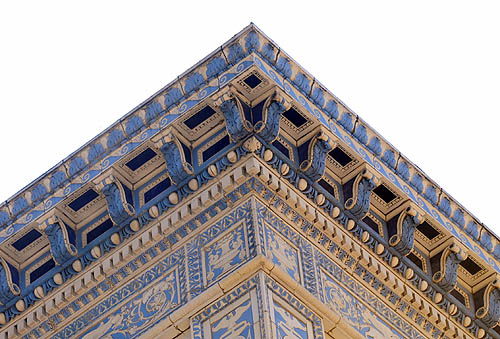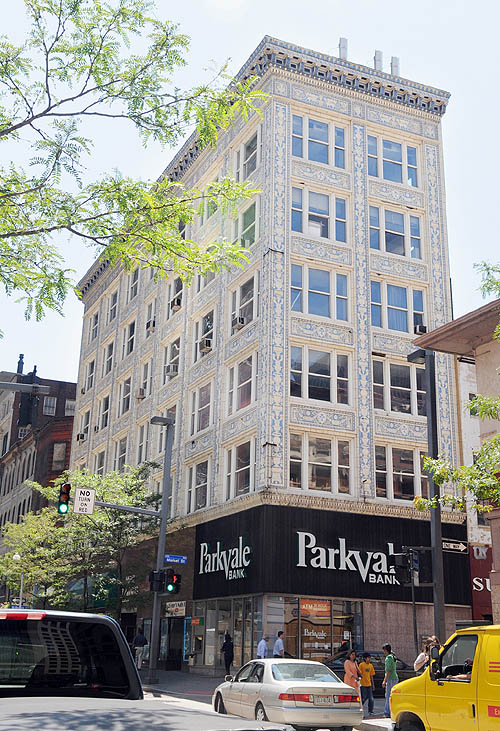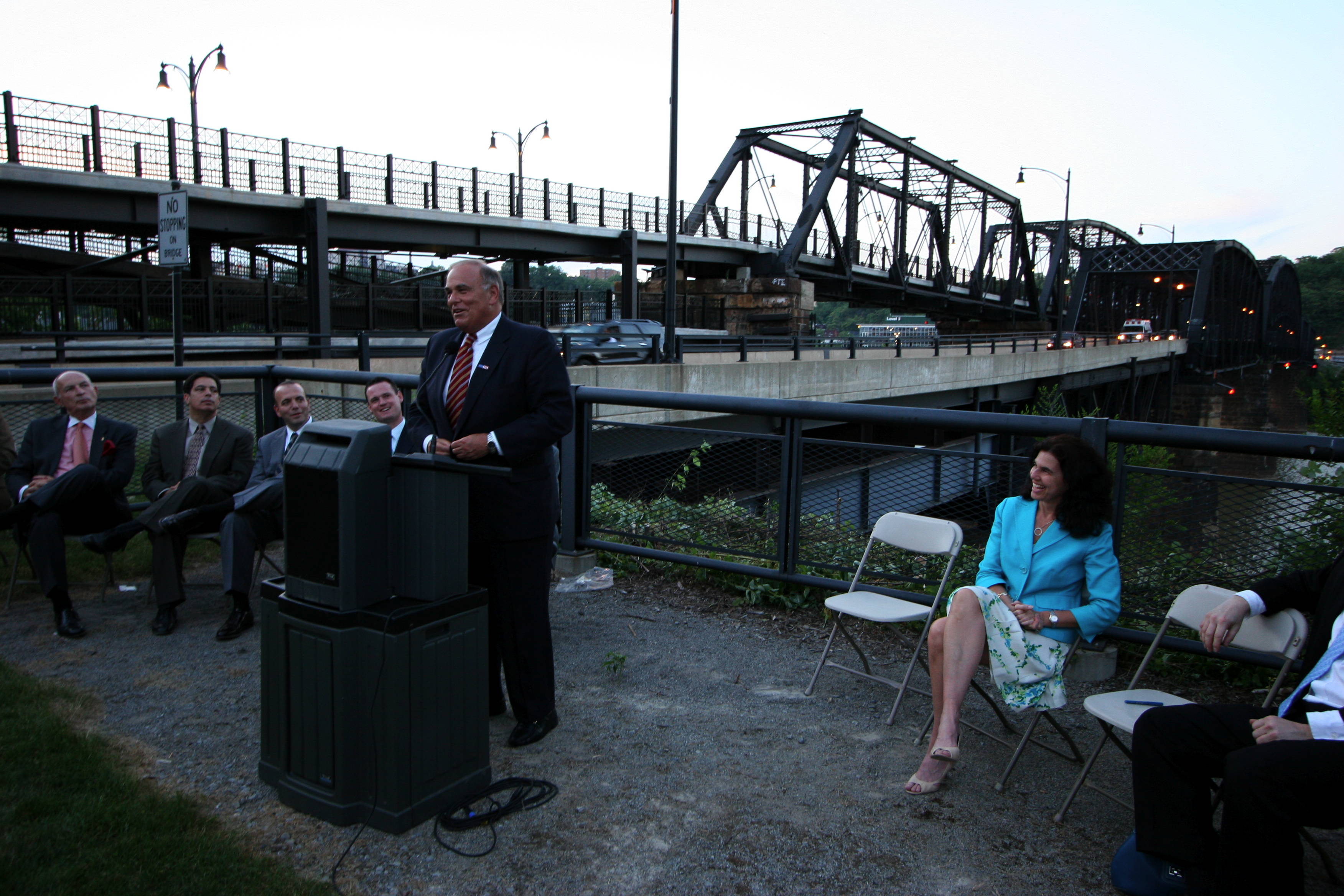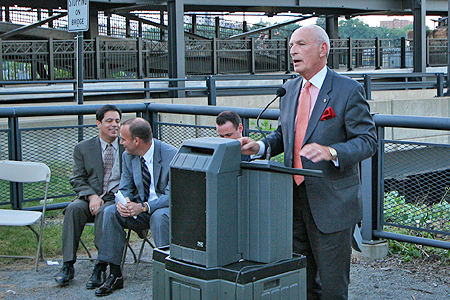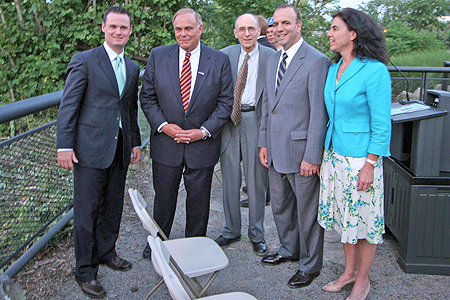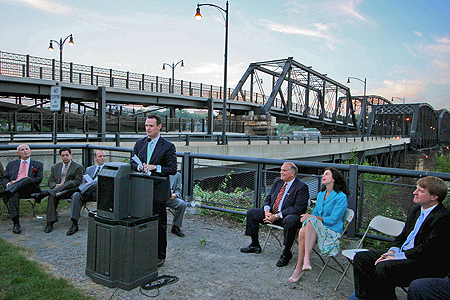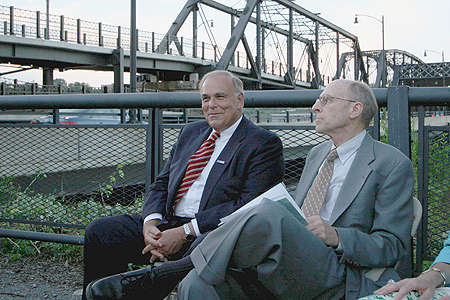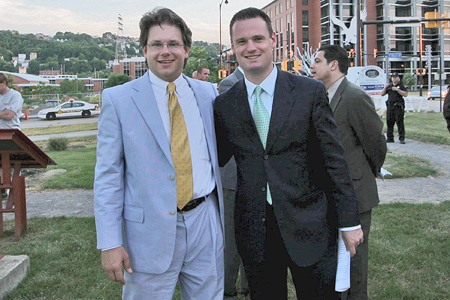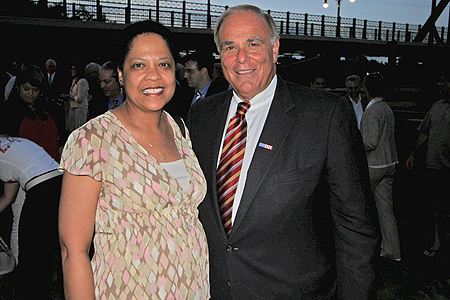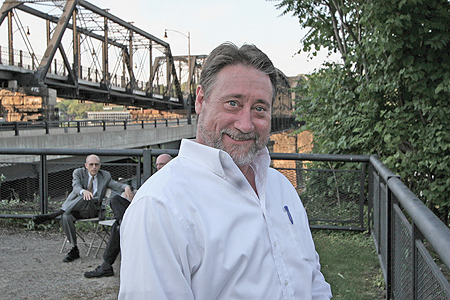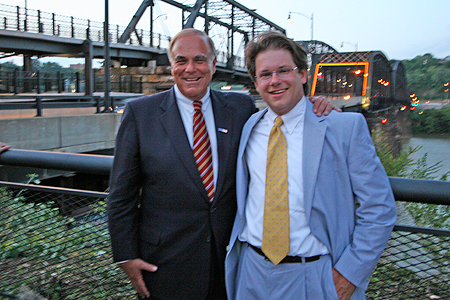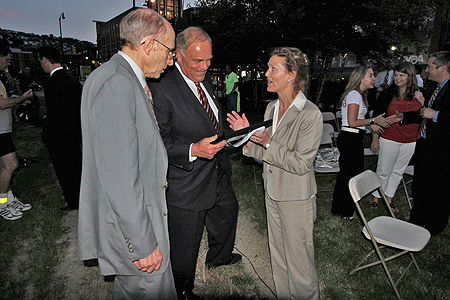
Category Archive: Architecture & Architects
-
Council delays vote on status of historic North Side shelter
By The Tribune-Review
Thursday, July 17, 2008Pittsburgh City Council delayed a vote Wednesday on whether to give historic protection to a North Side building that serves as a Salvation Army homeless shelter and chapel.
The Salvation Army wants to demolish the 81-year-old building, which once served as the headquarters of the Ancient and Illustrious Order of the Knights of Malta, a social and community service club.The Mexican War Streets Society and North Side historic preservationists want to save the building because they believe its removal would ruin the historic character of the neighborhood. Council could consider the matter in two weeks.
-
Councilman protests forced preservation of Malta Temple
By Jeremy Boren
TRIBUNE-REVIEW
Tuesday, July 15, 2008Forcing the Salvation Army to preserve an 81-year-old North Side religious and social services center would violate a city rule that says a church’s owner — not interlopers — must willingly seek historic protection, a Pittsburgh councilman said Monday.”Churches have an inherent right to have control over their own property,” said the Rev. Ricky Burgess, a councilman and pastor of Nazarene Baptist Church in Homewood. “They have autonomy in terms of seeking historic designation.”To back up his claim, Burgess cited a 2003 amendment to the city’s historic preservation law sponsored by then-Councilman Bob O’Connor.
The amendment states: “Nomination of a religious structure shall only be made by the owner(s) of record of the religious structure.”
A religious structure is defined as a “place of religious worship.”O’Connor fought for the amendment under the belief that some churches can’t afford to make repairs or facade improvements to comply with historic preservation standards.
Burgess said Sunday church services have been held regularly for nearly 35 years in the Salvation Army-owned property commonly known as the Malta Temple building because it is the former headquarters of the Ancient and Illustrious Order of the Knights of Malta.
The nonprofit Mexican War Street Society, a historic preservation group, nominated the Malta Temple for historic protection in January to prevent the Salvation Army from demolishing it.
The city Planning Commission and Historic Review Commission approved the nomination. It faces a preliminary vote Wednesday before City Council.
David McMunn, president of the society, said the Malta Temple is zoned as a commercial structure, not as a church. Allegheny County assessment records confirm that.
McMunn said tearing down the stately brick building at 100 W. North Ave. and replacing it with a modern building nearby would remove an important thread from the North Side’s already frayed historic fabric.
McMunn and other historic preservationists want the building to be renovated.
“The Salvation Army has first and foremost been a place of worship,” said Maj. Jim LaBossiere, Allegheny County coordinator for the organization.
LaBossiere agreed with Burgess’ argument.
He said religious services are held at 9:30 and 11:30 every Sunday morning in the Malta Temple building. The center doubles as a daytime homeless shelter where the indigent can receive lunch, counseling and use shower and laundry facilities.
Salvation Army officials have said previously that renovations would be too costly and that the building isn’t large enough to accommodate plans for additional worship, classroom, gymnasium and computer lab space.
“They don’t seem to see the need to partner with the neighborhood,” McMunn said. “Well, they need to because, as residents, we’re here forever.”
Jeremy Boren can be reached at jboren@tribweb.comor 412-765-2312.
-
Buhl Building ready for its closeup
Friday, July 04, 2008 -
Public Hearing on St. Mary’s Academy Building
PREPARED TESTIMONY OF
ANNE E. NELSON, ESQ.
GENERAL COUNSEL
PITTSBURGH HISTORY & LANDMARKS FOUNDATION
BEFORE HISTORIC REVIEW COMMISSION, CITY OF PITTSBURGH
PUBLIC HEARING ON ST. MARY’S ACADEMY BUILDING
CITY HISTORIC STRUCTURE NOMINATION
JULY 2, 2008
Pittsburgh History & Landmarks Foundation (Landmarks) strongly supports the nomination of the Academy Building of the St. Mary’s Church complex to become a City-Designated Historic Structure.
The St. Mary’s Academy Building was listed on the first county-wide architectural survey conducted in the United States, undertaken by Landmarks in 1966, and chosen as one of the buildings published in Landmark Architecture of Allegheny County Pennsylvania by James D. Van Trump and Arthur P. Ziegler, Jr. The Academy Building was also listed in 1979 in the second countywide survey of historic architectural sites conducted by Landmarks, in association with the Commonwealth of Pennsylvania. It was chosen for inclusion as one of 600 out of the 10,000 surveyed in the major book based on this survey, Pittsburgh’s Landmark Architecture by Walter C. Kidney, published in 1997. Both Van Trump and Kidney consider the Greek Revival c. 1850 Academy Building a significant surviving example of an important American architectural style. Furthermore, its “curious ornamental cast iron porch” is “the sort usually associated with New Orleans or Mobile although once common too in the industrial North.”
In 1989 historian Roger Kennedy noted in his National Trust book Greek Revival America: “The Northern Greek Revival was at least as vigorous and diverse as that in the antebellum South; but all the great houses of the North … have fallen victim to that region’s industrial success.” This is also true of banks, courthouses, and modest Greek Revival structures like St. Mary’s Academy, and we should protect the limited number of survivors.
Of the buildings in the St. Mary’s Church complex, the Academy Building is not only the oldest, but is the most architecturally unique and should, therefore, be deemed a City-Historic Structure.
-
Cathedral of Learning trumpets education
By Bill Zlatos
TRIBUNE-REVIEW
Sunday, June 29, 2008The Cathedral of Learning was constructed of Indiana limestone and built with the pennies, nickel and dimes of area schoolchildren.John G. Bowman, then chancellor of the University of Pittsburgh, came up with the idea for a tower in 1921.
“He wanted a tall building because his intention was the children of working men and women of Pittsburgh would see the tower and be inspired to get an education,” said Albert Tannler, historical collections director at the Pittsburgh History & Landmarks Foundation.

But there was the issue of money. The cost of the building was estimated at $10 million to $15 million, a hefty sum in those days.
In 1925, Marcus Aaron, chairman of the city’s board of education, summoned the district’s teachers to start a “Buy a Brick” campaign. The teachers told students to give 10 cents to Pitt and tell the university how they earned it. The children would get a certificate indicating they owned a piece of the building.As a result, 97,000 certificates were issued.Parents also gave. In 1926, Bowman went to a meeting of steelworkers and their families in Carnegie to promote his tower.
“A woman stood up with a baby in her arms and said, ‘We got no money, but we’ll go without meat for a week and give you that money.’ Then a man stood up and said, ‘I’ll wear this suit another year and give you the money,’ ” said Maxine Bruhns, director of Pitt’s Nationality Rooms and Intercultural Exchange Programs, who is working on a DVD, “The Story Behind the Construction of the Cathedral of Learning.”
The cathedral is home to 27 Nationality Rooms, which showcase the culture of the ethnic groups that built Pittsburgh.
The steel skeleton of the building was erected in 1929. After the stock market crashed, the 52-story design was shortened to 40. Still, it was the tallest academic building in the world when it was finished in 1937. It remains the biggest in the United States.
“It was a triumph,” Bruhns said, “symbolizing that those parallel lines going skyward never meet and education never ends.”
Bill Zlatos can be reached at bzlatos@tribweb.com or 412-320-7828.
-
$80 million Schenley tab challenged
By Christian Morrow
June 27, 2008
The New Pittsburgh Courier -
School board votes to close Schenley building
Thursday, June 26, 2008 -
Hot Metal Bridge Lighted
PHLF News
June 13, 2008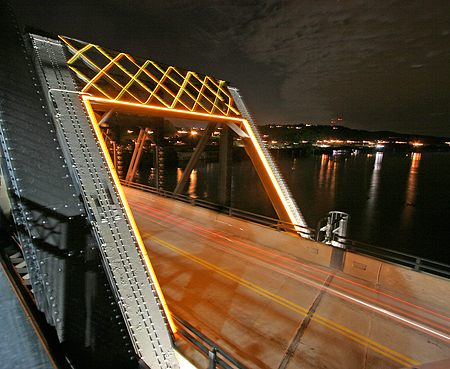
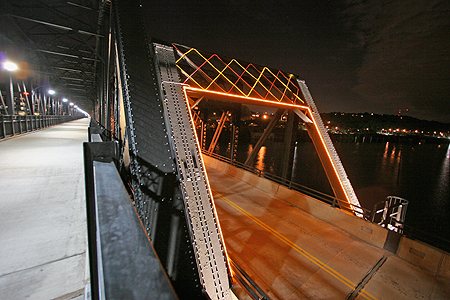
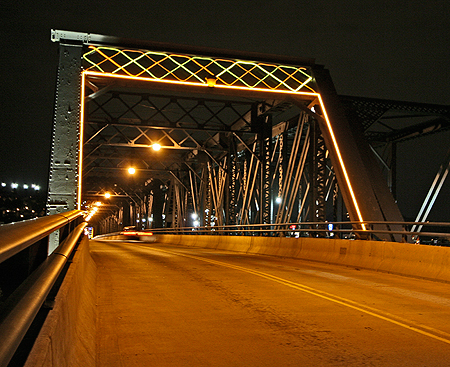
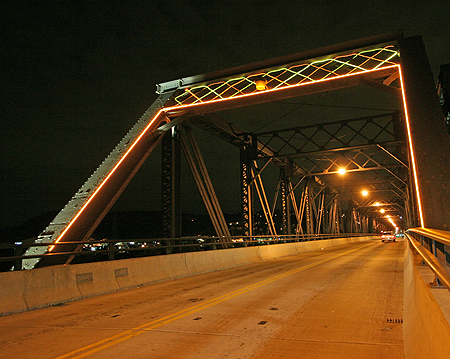
Governor Edward G. Rendell, accompanied by Mayor Luke Ravenstahl, activated the lighting of the portals of the Hot Metal Bridge, as it is commonly called today, at 8:15 p.m., Thursday, June 12, 2008.
The ceremony took place at the Steelworkers’ Monument on the South Bank of the Monongahela River. This was the third bridge decoratively lighted under the auspices of Pittsburgh History & Landmarks Foundation (Landmarks). The first was the Smithfield Street Bridge and the second was the Roberto Clemente Bridge.
Actually, the portal lighting decorates the Main Bridge (Monongahela Connecting Railroad Bridge), constructed in 1904 and opened to motor vehicles in 2000. The Hot Metal Bridge of 1900 (opened to bicycles and pedestrians in 2007) replaced the original Hot Metal Bridge of 1887. With the opening of Hot Metal Street in South Side Works, the name “Hot Metal Bridge” is now commonly used to refer to the historic bridge pair that is built on a shared set of piers.
Historically, hot metal––iron just smelted in a blast furnace and still close to 3,000 degrees Fahrenheit—was transported in ladle cars from the blast furnaces on the north shore of Jones & Laughlin’s Pittsburgh Works across the Hot Metal Bridge of 1900 to the Bessemer converters and open-hearth furnaces of the South Side Plant. The Main Bridge of 1904 served the general purposes of the Monongahela Connecting Railroad, including the transportation of steel ingots and slabs.
The bridge lighting is LED tubular lighting in orange, red, and yellow, suggesting the colors of the hot metal and steel slabs that were once transported across the bridges.
Grenald Waldron Associates of Philadelphia designed the lighting for the bridge as they did for the Roberto Clemente Bridge. Courtney Sarge was the principal designer.
The Governor said, “Grenald has done excellent work once again, we are delighted to see Landmarks utilizing Pennsylvania designers and Pittsburgh contractors for the work that they do with bridge lighting.”
Funding for the project came primarily from a grant from the Department of Community and Economic Development at the Governor’s request. That grant totaled $125,000. Design of the lighting was financed by grants from the Soffer Corporation, the International Brotherhood of Electrical Workers, Wellington Power, and Landmarks totaling $12,500. Landmarks also underwrote an additional $15,000 of costs for the project, bringing the total to approximately $150,000.
Mayor Ravenstahl pointed out, “This is another fine public-private accomplishment in our goal to make Pittsburgh a uniquely attractive city by capitalizing on our historic assets. We thank the Governor and Landmarks and our city team for bringing about this excellent result.
Mark Bibro, Chair of Landmarks, said, “We are grateful that we have a governor who understands the significance of lighting these great engineering monuments to promote their continued use and increase tourism. We are the ‘City of Bridges,’ with 446 bridges (based on the most recent count) within the City limits, and hundreds more throughout Allegheny County. We must continue this lighting program.
Founded in 1964, the Pittsburgh History & Landmarks Foundation works to identify and save architectural landmarks; revitalize historic neighborhoods; and instill community pride. Visit www.phlf.org or call 412-471-5808 for information about preservation services, educational programs, and membership benefits.
# # #

